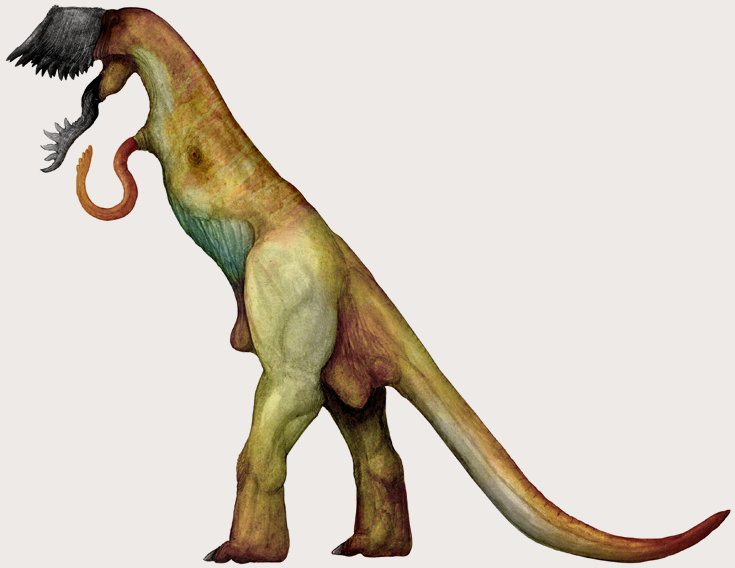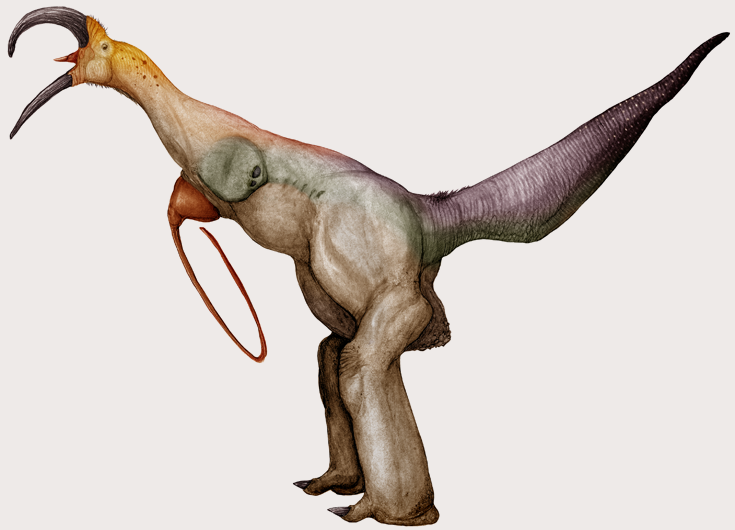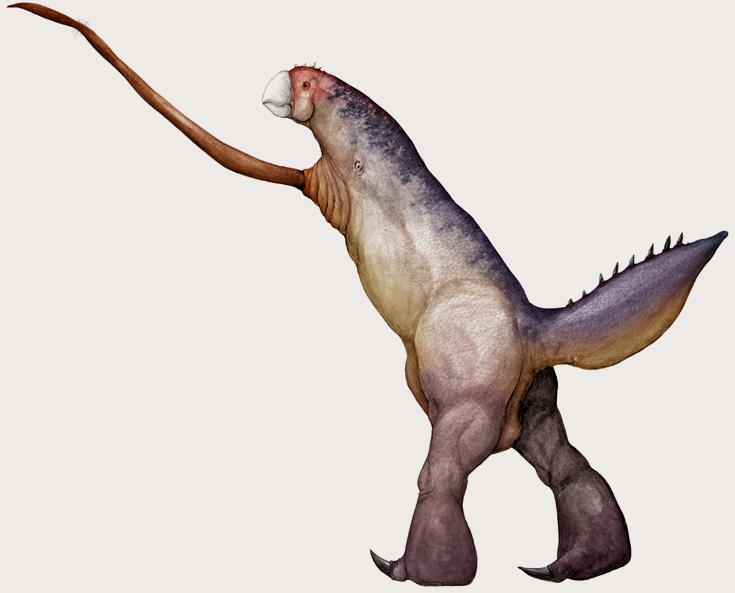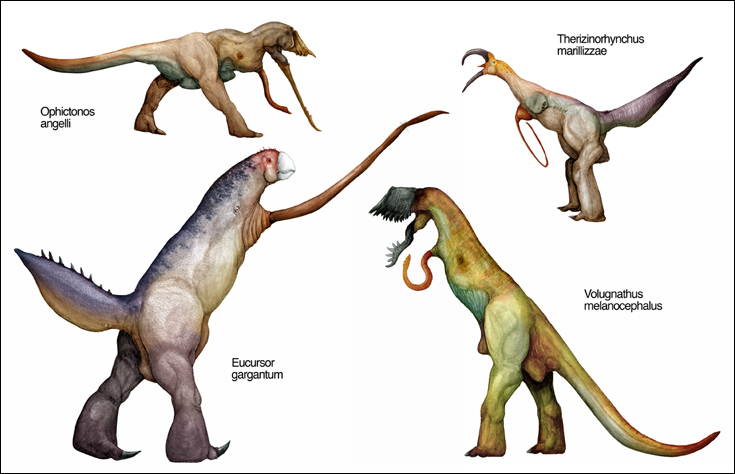Monoanticherans
Evolved in the distant isolation of Thalassia, this lineage of bipedal carnivores and herbivores resembles no other group on Snaiad. Monoanticherans are notable for the complete absence of front limbs and a peculiar rear limb structure with singular toes and unique, double-jointed knees. Their first heads have a pronounced split between the upper and lower mandibles and the series of pouches and cheek-like flaps that help rear the young in other lineages are usually absent. As a result, Monoanticherans are obligate egg-layers, although they care for their leathery, handbag-like eggs as much as livebearers care for their young.
The origins and relations of these unusual animals are not clearly understood. They clearly seem to have something in common with other unique fauna of Thalassia such as Tromobrachids and Titans, and all these groups seem closest to the primitive stem-herbivores on the mainland continents. The exact details of these relations, of course, remain frustratingly unknown.

Species: Ophictonos angelli
Common Name: Snake-Eater, Mikado.
Size: 1- 1.5 meters long.
Habitat: Plains and sprogland on Thalassia.
While most Thalassian animals seem to be wildly different from their mainland counterparts, certain basic body plans, such as the snake-like sprog crawlers, have evolved here as well. With Thalassian “snakes,” of course, come Thalassian Snake Eaters. The two species of Ophictonos seem to be local equivalents of the Pescidont Sprog-probers (Vermidonta,) hunting their abundant serpentine quarry with the disjointed, spear-like lower jaws on their first heads. These creatures usually hunt alone, jabbing and probing the ground in a continual search for food. Prey items are skillfully impaled on the lower jaws and then removed and consumed by their dexterous, trunk-like second heads. During the lean seasons, groups of them wander into the jungles to probe the forest floor, or scout the edges of raging wildfires to catch small animals flushed out by the blaze.
The males of this species have a very quirky ritual to impress females, which earns them their second most common name: “Mikados.” During the mating season, they gather sticks and branches with their hand-like second heads and line them up in neat rows near their nests. When a female approaches, they begin flipping the sticks up into the air with their long spears. This apparently impresses the females very much and they quickly join the game, flipping sticks together with their suitor. Mating takes place after an indeterminate period of stick flipping. These rituals, while funny to watch, clearly show the loose boundaries between play and mating behavior in nature.

Species: Volugnathus melanocephalus
Common Name: Volugnath.
Size: Up to 8 meters long.
Habitat: Jungles and forests in Thalassia.
After the famous See Rex, this lanky giant is the second-largest predator on Thalassia. More of an ambush predator than a long-range chaser, Volugnathus lurks in forest thickets, striking out in a sudden burst of action to dispatch its prey. Death to its victims always comes from a knockout blow of its robust, ax-like upper first-head jaw. In contrast, the lower jaw is a disjointed, fragile and highly mobile implement, much like the spears of the Snake Eaters. After the prey has been killed, this halberd-like organ helps Volugnathus skin and dismember its remnants, which are finally swallowed with the help of its trunk-like second head. While Volugnathus usually feeds on fellow herbivorous Monoanticherans or forest living Titans, smaller animals and carrion also forms a percentage of its diet.
Although quite large, Volugnaths are lightly built and vulnerable against other predators. As a result, they prefer running away to open confrontations unless they have the advantage of surprise. As an additional means of defense, males of this species are able to squirt an extremely irritating, sticky fluid from special ducts beneath their first-head jaws. This fluid, interestingly enough, is actually a modified version of its semen, composed of inert, dead “sperm cells” that are produced outside the normal mating season. This defense tactic has also independently evolved among the Haplobrachid Ophimyids and Citognaths.

Species: Therizinorhynchus marilizzae
Common Name: Mary-Lisa’s Bounderjaw, Yellow Bounderjaw.
Size: 1.2-2 meters long.
Habitat: Plains and sprogland throughout Thalassia.
The dozen or so species of Bounderjaws (Pistonopodidae) make up the majority of herbivores on Thalassia. These creatures sport a strange mixture of ancestral and derived characteristics; their legs have specialized, piston-like hydraulic muscles that store energy from one bound to another as they leap about, while they still retain the traces of their front limbs as flap-like extensions that lie folded against their bodies.
Although larger Bounderjaw species dwell by themselves, Therizinorhynchus marilizzae is a communal browser that patrols the plains in groups of up to twenty individuals, looking for the fruit-bearing shrubs and succulent-leaved trees that dot the Thalassian plains. Unlike many other herbivores, Bounderjaws do not have the advanced digestive equipment necessary to tackle sprog, another sign of their primitive nature.

Species: Eucursor gargantum
Common Names: None.
Size: 5 meters tall.
Habitat: Edges of jungles and gallery forests across Thalassia, dwarf forms also found on surrounding islands.
The giant herbivore niche on Thalassia is taken up mainly by the Titans, (Titaniformes) but Monoanticherians have also made a stab at it with the aptly named Eucursor gargantum. These lumbering giants have hugely extended, muscular second-head tongues that are almost as long as their bodies. With the aid of these organs, they can browse on the highest trees in the Thalassian forests, something no Titan species is capable of doing. Such a feat, of course, requires remarkable adaptations and consequently Eucursor has highly developed muscles to extend its second head, a series of cartilaginous support struts that run along the second head itself and special, self-constricting blood and hydraulic vessels to squeeze out the exertion of supporting the entire mechanism.
Another remarkable adaptation of these herbivores is the presence of skin flaps surrounding their first-head faces. Being egg layers, all other Monoanticherians lack such structures. Eucursor is also an egg layer, although its cheeks and gular sac enables it to carry the eggs around after it has laid them. The females give "birth" to two, rarely three young, which stay with them until they can safely graze on their own.
Copyright laws protect all intellectual property associated with Snaiad.
All artwork, concepts and names associated with this project belong to C. M. Kosemen, unless otherwise stated.
